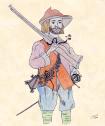
|
|

|
|
| {Version Française} | {Versión
Española} |
This site is about the organisation, the tactics, the battles and campaign of the famous Spanish Tercio in the XVI and XVII century. Enjoy the site and do not hesitate to send me your comments at the e-mail written in the Index page.

Contents / Chapter:
1. Introduction 2. Organisation of the Spanish army
Note: to see the last
news of the site, please check the Index page,
thank you
1.1 IntroductionThe military history of the XVI and XVII centuries has his importance with the "military revolution" from the middle age small armies to the huge Napoleonic army of the XVIII century. Technical progress of the portable firearms and tactical knowledge had reduced the importance of the heavy medieval cavalry, introduced the importance of the artillery in the battlefield and positioned the infantry as the main corps in the army.
The Spanish Tercios were the new infantry unit of the Kings of Spain which combined the firepower of the harquebus (later the musket) with the pikes. The Tercios would form the elite forces of the Spanish monarchy during 200 years. Contrary to others troops they fought only for one master, the King of Spain. .
1.2 The origin
After seven centuries of war against muslin warriors, the "reconquista" of Spain was over in 1492. These wars had created an original Spanish army where the infantryman had as much importance as the heavy knight. In 1495 the Spanish King Fernando V "El Catolico" (the Catholic) reorganised the defence of his reunified kingdom. The first permanent forces were the capitanias or companies of 100 to 600 men. A capitanias used to have pikemen (called lanceros), crossbowmen or rodelos (buckler and stabbing sword men) and handguners. In january 1496, a royal ordinance was published to fix the company staff, mainly: 1 captain, 1 alférez, 1 sergeant, 1 barber and 1 chaplain.
From 1496, the Spanish began to send troops to fight in Italy against the French and some Italian princes. In 1500 the Spanish army in Italy, had 3042 infantrymen (23 capitanias), 300 men at arms (3 companies) and 300 "jinetes" (3 companies of light horsemen). The infantrymen were armed with 4.6 m pikes (called lanzas in Spanish), crossbow and some fire handgun (27% of the total).
Around 1504 the Spanish commander Gonzalo de Córdoba (called el Gran Capitán) organised groupment of 12 - 16 capitanias, the coronelía (colonelcy) manded by a Coronel (Colonel). In 1509 for the expedition to Oran, the coronelia of Vianelo had 16 capitanias and 2762 hommes,the coronelia of Don Francisco Marqués had 13 capitanias and 1950 men, but the coronelía of Antón de Avila had only 8 capitanias and 1659 men. We have an average of 172 men per capitanias.
After, the coronelía was composed of 6 and 4 companies of 300 men. By 1525, the 7050 Spaniards were divided in 33 companies of infantry. Each company had between 100 and 350 men with an average of 27% of Harquebusiers.In 1534, the Spanish troops in Italy were reorganised in three units. In 1535, the name of Tercio appeared to design these units called Lombardia (Lombardy), Napoli (Naples) and Sicilia (Sicily). Their mission was to protect the Spanish territories in Italy.
[Contents] [Chapter 1] [Chapter 2] [Chapter
3] [Chapter 4] [Chapter 5] [Chapter
6] [Chapter 7] [Chapter
8]